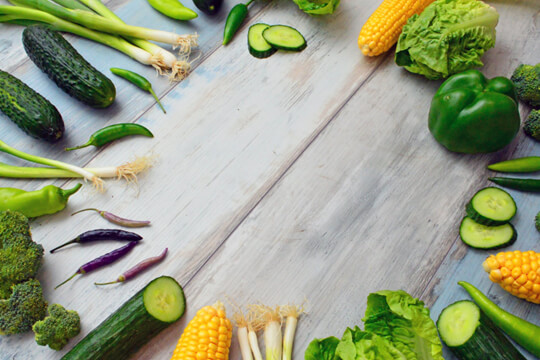One of the characteristic aspects of Japanese food, which is registered as an intangible cultural heritage, is that it incorporates seasonal ingredients.
Differences between the four seasons are distinct in Japan, and each season has its own respective seasonal ingredients. Bringing those seasonal ingredients into Japanese food shows care not just for the flavor, but for giving a sense of the season.
If you want to enjoy Japanese food, simply understanding the link between dishes and the seasons can completely change how you experience them. That’s why we’d like to talk about seasonal ingredients and why the Japanese are so particular about them.
Dishes are seasonal
The four seasons in Japan are very distinct, and each ingredient has its own best season. The “best season” for an ingredient is the season when the fish and vegetables used in the dish can be caught and harvested, and when the ingredient is at its most flavorful. Thanks to technological innovations, there are now many vegetables that line supermarket shelves year-round. However, their flavor can’t match vegetables raised naturally and harvested at their peak. Let’s take a look at some noteworthy ingredients and their seasons.
[Spring] March – May
・Sprouts like watercress and butterbur
・Fruits like strawberries, kiwis, sumo mandarins and cherries
・Fish like sea bream, herring and Spanish mackerel
[Summer] June – July
・Produce like cucumbers, tomatoes, watermelons and eggplant
・Fish like skipjack tuna and seafood like octopus and eel
[Fall] September – November
・Tubers like potatoes and sweet potatoes
・Mushrooms like matsutake
・Fish like salmon and seafood like oysters
[Winter] December – February
・Leafy greens like Chinese cabbage and spinach, as well as vegetables like green onions
・Citrus fruits like satsuma oranges and lemons
・Seafood like crab and fish like cod
As Japan is spread out from North to South, harvest periods differ slightly from region to region, and there are some places where certain things cannot be harvested. Experiencing the seasonal flavors of each region is one of the joys of dining in Japan.
Why the Japanese have such a respect for seasonal ingredients
Not simply limited to not simply limited to dishes crafted by professional Japanese chefs, Japanese people have put a great importance on seasonal ingredients since long ago.
chefs, Japanese people have put a great importance on seasonal ingredients since long ago. The reason why Japanese people place such an importance on seasonal ingredients isn’t just because that’s when they are the most delicious.
In addition to seasonal ingredients being less expensive, their nutritional value is higher. Eating those seasonal ingredients can give your body the nutrients it needs to get through that season. For example, the water content of watermelon is high, and it’s said that it can cool the body and help prevent dehydration. Watermelon is just a single example, but the Japanese have known from long ago that eating seasonal ingredients can help people take in necessary nutrients and lead a healthy life.
Additionally, the Japanese food made by chefs have a high value placed on their coloring and beauty. Seasonal ingredients are used so that you can get a sense of the season and a sense of satisfaction just by looking at the dish.
Tasting the first of the season
Even among seasonal ingredients, we recommend those from the first harvest or catch. First of the season ingredients are those from the initial harvest or catch for that ingredient each year. Many producers use ingredients gathered during that time as offerings to the gods in thanks for a successful harvest or catch.
In the Edo period from the 1600s to the 1800s, when samurai were still around, it was said that partaking of the first harvest or catch would extend one’s life by 75 days and that people would compete to try to get their hands on the first of the season. While the first harvest or catch doesn’t have nutritional values that are comparatively high, partaking of them while being aware of this culture brings an altogether different experience.
As a remnant of the Edo period, first of the season products sometimes come with a premium price tag, even today. One famous example is melons. First-harvest melons produced in Hokkaido’s Yubari City are famous for the high price they fetch. In 2019, two first-harvest Yubari melons cost 5 million yen.
Summary
If you have the opportunity to experience authentic Japanese food, try to make note of the seasonal ingredients on the menu offered. You’ll be able to feel how much the chef wants you to experience the season visually.
Additionally, if you’re drinking sake at home, you can enjoy the flavors even more if you partake of it with dishes prepared with seasonal ingredients while thinking about Japan.
【References】
農林水産省 ~ 食べ物と日本の四季
しきたり.net ~ 旬の食材の栄養!季節ごとのおすすめの旬菜や魚、果物をご紹介!
住まいの情報ナビ ~ 季節の食材を食べるメリットは?
住まいの情報ナビ ~ 季節の野菜カレンダー
住まいの情報ナビ ~ 季節のフルーツカレンダー
Macaroni ~ 食べておきたい春の果物10選!おいしい見分け方とレシピも♪
住まいの情報ナビ ~ 季節の魚介
四季と行事食 ~ 日本食の四季
ミールタイム ~ 日本の伝統食 78 季節感を大切にした
農林水産省 ~ 和食を切り口とした子育て世代の地域を通した食育推進
食育ずかん ~ 季節を大切にし、季節を味わい楽しむ「和食」のお話。
日本の行事・暦 ~ 旬の食材
食品産業新聞社ニュースWEB ~ 【食品産業新聞社】夕張メロン 初競り2玉500万円で落札、「北海道夕張メロンのソーダ」10周年記念/ポッカサッポロフード&ビバレッジ
YAMA HACK[ヤマハック] ~ 食べられる野草【写真付き/春夏秋冬一覧】
